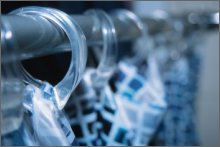The Most Dangerous Toxin that Almost No One Knows About
by www.SixWise.com
Most everyone is exposed to small amounts of manganese, a
naturally occurring substance in our air, soil, water and
food, daily. If kept in check, the body is able to control
manganese levels by expelling extra amounts, but if the intake
becomes too great, it can become overwhelming and cause a
variety of health problems, including permanent nervous system
damage.
What makes manganese so dangerous is that the current safety
levels may not be adequate, so people may be taking in dangerous
levels of this compound that almost no one is aware of.
|

Is there a hidden danger in your shower?
|
Nearly 9 Million Americans Exposed to Dangerous Manganese
Levels
According to a study by John Spangler, M.D., an associate
professor of family medicine, and other researchers from Wake
Forest University School of Medicine, "Nearly 9 million
people in the United States are exposed to manganese levels
that our study shows may cause toxic effects."
Exposure can occur via many routes, drinking water, foods,
manganese-containing pesticides, air, and more, but the researchers
found that the most concerning source may come from something
most of us do daily: shower.
The study found that after showering 10 minutes a day for
10 years in manganese-contaminated water:
-
Children would be exposed to doses of manganese three
times higher than doses that resulted in manganese deposits
in the brains of rats.
-
Adults would be exposed to doses 50 percent higher than
the rats.
Damage may Occur at Levels Considered Safe by the EPA
Perhaps most concerning is that permanent damage to the nervous
system may occur after exposure to manganese levels that the
Environmental Protection Agency (EPA) has noted as safe.
According to the EPA, 0.5 milligrams/liter is the upper limit
of manganese in water supplies, based on odor and taste of
the water. However, the amount of manganese accumulated by
breathing in shower vapors has not been considered, and even
at 0.5 milligrams/liter researchers say manganese could cause
brain injury.
"Inhaling manganese, rather than
eating or drinking it, is far more efficient at delivering
manganese to the brain," Spangler said. "The
nerve cells involved in smell are a direct pathway for toxins
to enter the brain. Once inside these small nerves, manganese
can travel throughout the brain."
Health Risks of Manganese
High levels of manganese are toxic to the nervous system
and can cause:
According to Spangler, the elderly, pregnant women, children
and people with liver disease are particularly susceptible
to manganese toxicity, and may develop problems even at low
doses in water supplies.
"If our results are confirmed, they could have profound
implications for the nation and the world," Spangler
said.
Major Sources of Manganese
People who work in, or live near, a factory that produces
manganese metal are likely exposed to high levels of manganese
dust in the air. Likewise, those living near a coal- or oil-burning
factory are also exposed to high levels, as manganese is released
into the air when fossil fuels are burned.
Manganese is also added to some gasoline, which could pose
a threat to those living in urban areas, working in garages
or spending a lot of time in bus stops.
Further, "The manganese, as it settles from car exhaust
onto streets and highways, may enter the water supply, increasing
manganese levels in the water we drink and bathe in,"
said Spangler.
|

Don't worry about naturally occurring manganese in
food--toxicity from this source has never been documented.
|
Other potentially risky sources include:
-
Soy infant formula: Soybean plants may take in manganese
from the soil and concentrate it. Soy formula may have
200 times the manganese level found in breast milk, which
can lead to brain damage in infants and behavioral changes
in adolescents, according to Dr. Francis Crinella, clinical
professor of pediatrics at UC-Irvine, and Trinh Tran,
a graduate researcher at the UC-Davis Department of Animal
Studies.
-
Wells and private water supplies (may contain higher
levels than public water supplies)
Reducing Your Risk of Manganese Toxicity
Manganese is a necessary nutrient that should be included
in your diet. Limiting foods that contain manganese is therefore
not a good idea, as toxicity from manganese in foods has not
been documented. Rich food sources of manganese include whole
grains, nuts, leafy vegetables and tea.
If you are concerned of your exposure to manganese via water
supplies or air, however, it would be prudent to take precautions,
including:
-
Have your drinking and bathing water tested for manganese
levels
-
Invest in a water filter and shower filter that will
remove manganese, if necessary
-
Try to avoid congested urban areas and other regions
with a lot of exhaust fumes
-
Avoid living near or working in manganese metal or
coal-burning factories if possible
Recommended Reading
Magnesium:
Why Your Heart is Begging You for More of This Essential Nutrient
Dangerous
Toxic Fumes from Six Everyday Products that You Most Want
to Avoid
Sources
Science
Blog: Shower Manganese a Public Health Threat?
Agency
for Toxic Substances and Disease Registry: Manganese
Medical
Hypotheses 2005, Volume 65, Issue 3, Pages 607-616
How
Safe is Soy Infant Formula?
The
Linus Pauling Institute